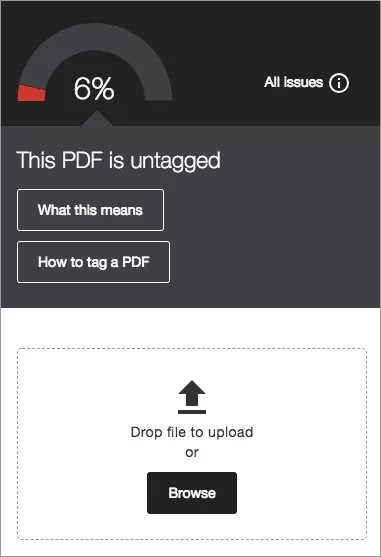Tag a PDF
Ensure that your documents and presentations stay accessible when converting to PDF
Although keeping your content in the original source file is the best way to ensure the document remains accessible, many instructors prefer to export their documents and presentations as PDFs. When exporting as PDF, it's important to check your export settings to make sure that the PDF will be tagged. This makes sure the PDF is easy to navigate.
If a PDF isn't tagged, the file gets a low accessibility score indicator.
Select the Accessibility score indicator to learn more and add a description.
Tag a PDF
You need to fix this issue in the original source file. For example, in Microsoft® Word. Open the file, save as a tagged PDF, and upload the updated file to your course. Select How to tag a PDF for step-by-step guidance on how to do this.
- Select How to tag a PDF and select Yes.
- Open the source file on your computer.
- Save the file as a tagged PDF.
- Microsoft Word: Select File and Save As. Select PDF from the File Format menu. Select Best for electronic distribution and accessibility and select Export.
- PowerPoint: You can't save PowerPoint files as tagged PDFs. Upload the PowerPoint file instead.
- LibreOffice Writer and Impress: Select File and Export as PDF. Select Tagged PDF (add document structure) and Export bookmarks in PDF Options. Select Export.
- Upload the updated file to your course.
If you still have the instructions open in the instructor feedback panel, select Next and Browse to upload your file. If you don't have the instructor feedback pane open, select the Accessibility score indicator next to the file in your course and select Browse to upload your file.
Add a library reference
It might be difficult for you to find the original source file. Reaching out to your library or accessibility services before the start of the term can help make sure students who need those formats don’t fall behind.
You can also add a library reference to Ally to help your students.
- Select No when asked if you can get hold of a text-based version.
- Select Yes when asked if the document or presentation can be found in the library.
- Fill out as much information in the Ally feedback form as you can and select Add reference.
After you add the library reference, students can access the document information by going to the file, and selecting Alternative formats from the menu next to the file name. Select Library reference.
Alternative formats
If you select No to both the text-based and library questions in the Ally feedback, Ally generates alternative formats for students to use. Unfortunately, this is not a final solution so it won’t improve the score. You will still want to tag the PDF when possible.



 Ally 사용자 그룹에 참여
Ally 사용자 그룹에 참여